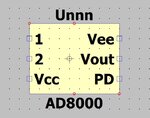stenzer
Advanced Member level 3
Hi,
the transfer function of an opamp acts like those of a first order lowpass filter. At the cut-off frequency the magnitude is already attenuated by 3 dB and a phase shift of 45° occures. As the AD8099 has a GBP of 3.9 GHz and your second stage has a gain of 10, your cut-off frequency is 390 MHz. The cut-off frequency of the first stage is 1.95 GHz. Note, the gain-bandwidth-product (GBP) is only applicable for voltage-feedback amplifiers (like the AD8099). As you can see, it depends on the intended/targed frequency. The blue trace (second stage output) results in a phase shift of about ~40° @ 420 MHz.
Please use lables to name your nodes/traces as those lables also appear in the plot and is much easier to identify the related curve. Therefore, make a RMB click on the intended trace, choose "Label Net", choose a name and place the labe on the trace/node. Re-run the simulation, now the vurves jave individual names instead of e.g. n010 within the brackets.
BR
the transfer function of an opamp acts like those of a first order lowpass filter. At the cut-off frequency the magnitude is already attenuated by 3 dB and a phase shift of 45° occures. As the AD8099 has a GBP of 3.9 GHz and your second stage has a gain of 10, your cut-off frequency is 390 MHz. The cut-off frequency of the first stage is 1.95 GHz. Note, the gain-bandwidth-product (GBP) is only applicable for voltage-feedback amplifiers (like the AD8099). As you can see, it depends on the intended/targed frequency. The blue trace (second stage output) results in a phase shift of about ~40° @ 420 MHz.
Please use lables to name your nodes/traces as those lables also appear in the plot and is much easier to identify the related curve. Therefore, make a RMB click on the intended trace, choose "Label Net", choose a name and place the labe on the trace/node. Re-run the simulation, now the vurves jave individual names instead of e.g. n010 within the brackets.
BR



